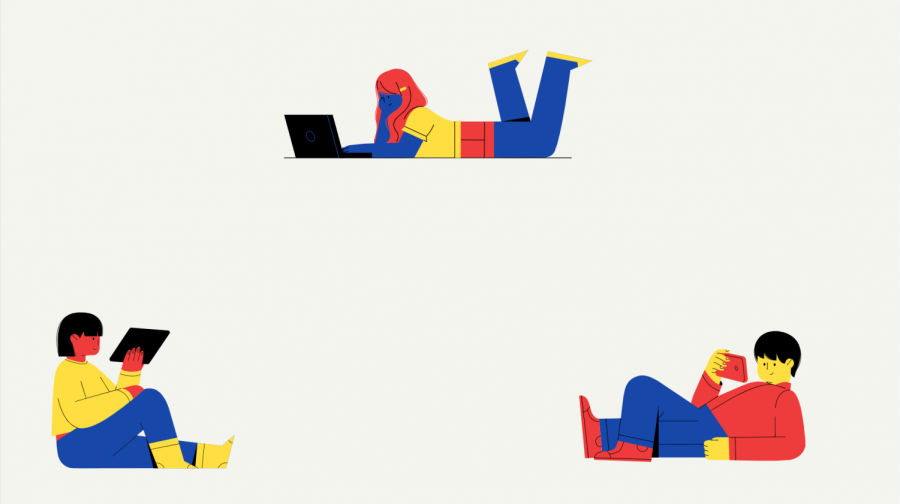Zoom Fatigue; and the Physical Effects on Students
December 10, 2020
By: Michelle Montanez
Zoom Fatigue. A term coined this year to describe the tiredness, worrying, and burnout associated with overusing virtual platforms to communicate.
Students who attend school virtually face challenges regarding physical health, some of which will be long term. Of course, unpleasant results were expected when school was first announced to be virtual. Sitting down and focusing on a computer screen all day was already an issue for office jobs, but now students across the country have to face the same problems.
Although virtual learning can have many psychological effects, most people are overlooking the additional physical effects of these educational alterations. According to Dwyer Education Strategies, about 50 to 90 percent of individuals behind the screen suffer from some degree of eye strain as a result of technology usage. For people with astigmatism and other visual impairments, even further damage could result over time. Computer Vision Syndrome, a group of eye and vision related problems that result from extensive use of digital devices, could escalate and negatively affect the ocular health of a person if online learning entirely overtakes traditional face-to-face learning.
“Many people will go to the ophthalmologist and complain about their eyes feeling uncomfortable, thinking there’s something wrong with their vision,” said Dr. Richard Shugarman, a volunteer professor at the Bascom Palmer Eye Institute to MyHealthNewsDaily.
Looking at a computer screen for a lot of time at once makes the eyes work harder. It’s very different from looking at pages from a book or paper. The letters on digital screens aren’t as precise or sharply defined, the level of contrast of the letters to the background is reduced, and the glare and reflections on the screen can make it difficult to view, causing headaches. This is why e-readers like Amazon Kindle have black text with a gray background: they’re actually made for long reads.
“Black on gray is easier for reading, versus black on a brighter white,” Shugarman said. “So it’s important to decrease the contrast if you find yourself developing headaches from trying to read off a screen.”
Additional demands on the visual system like constant eye focus and movement can also cause discomfort and strain on the eyes. Even people who wear prescribed eyeglasses or contact lenses can find it difficult to view the screen because their heads are at angles that the glasses aren’t designed for.
The health of both eyes and body have become rising concerns of doctors and pediatricians.
“I think they’re missing the exercise component of going out and walking to school and being at school,” said Navicent Pediatrician Dr. Christy Peterson to Fox News. “ Many children are just sitting at home trying to complete an enormous amount of work online and they’re struggling, and they’re having to work a little bit harder.”
As a result of the body and neck being at abnormal postures for prolonged periods of time, individuals may have muscle spasms or pain in the neck, shoulder or back. According to rxwellness, the skeletal system gets used to the hours of sitting in an unnatural position, which wreaks havoc on the body and posture, and can cause more serious long-term issues. Continuously sitting for hours on a day to day basis affects posture and may even cause physical pain, strain, and discomfort. Bad posture can reduce energy, contribute to depression, and cut off blood flow circulation.
“I’m an online learner and I definitely feel less active than I used to,” student athlete Angel Contreras said. “It’s harder to focus in practice and I get more sore than usual.”
American Optometric Association recommends to follow the 20-20-20 rule, and take a 20-second break to look at something 20 feet away every 20 minutes to prevent digital eye strain. Regarding posture, making the effort to sit correctly when sitting down will prevent the back and neck from being overly strained. Investing in a specially padded cushion or chair may also help to feel more comfortable while learning, or working from home. One of the most effective ways of maintaining a healthy posture is to get up and move around every once in a while. Taking physical as well as mental breaks builds productivity. Outside of school, there are many things available to help maintain a healthy lifestyle while still being socially distanced. These include: walking around a park, taking a class outside, or just exercising in the backyard.
“The body and the brain are always looking to maintain a balance or homeostasis,” said Psychiatrist Dr. Lim Boon Leng to CNA Lifestyle. “When things are stimulating and interesting, dopamine is secreted and gives us a sense of pleasure.”





















